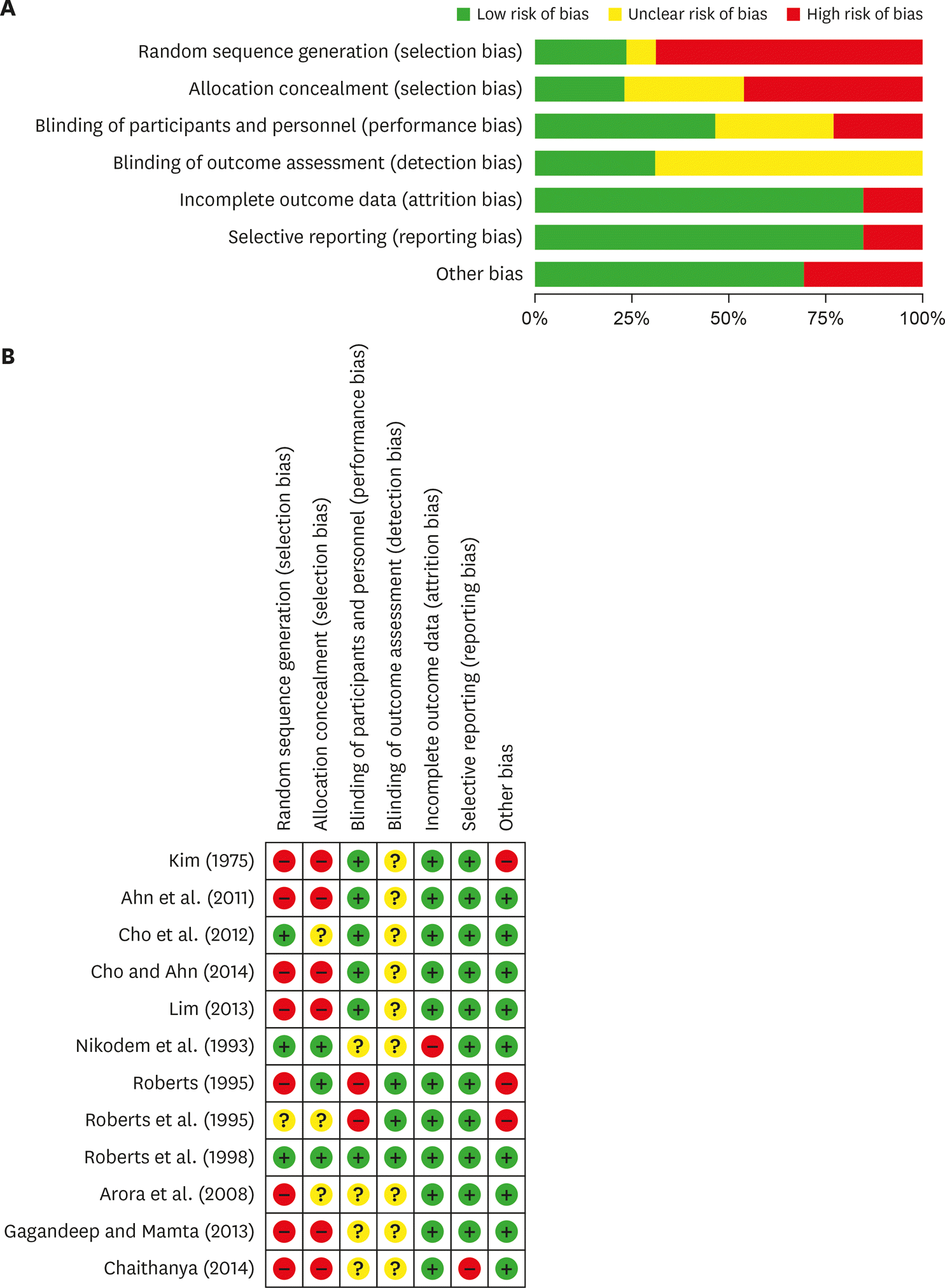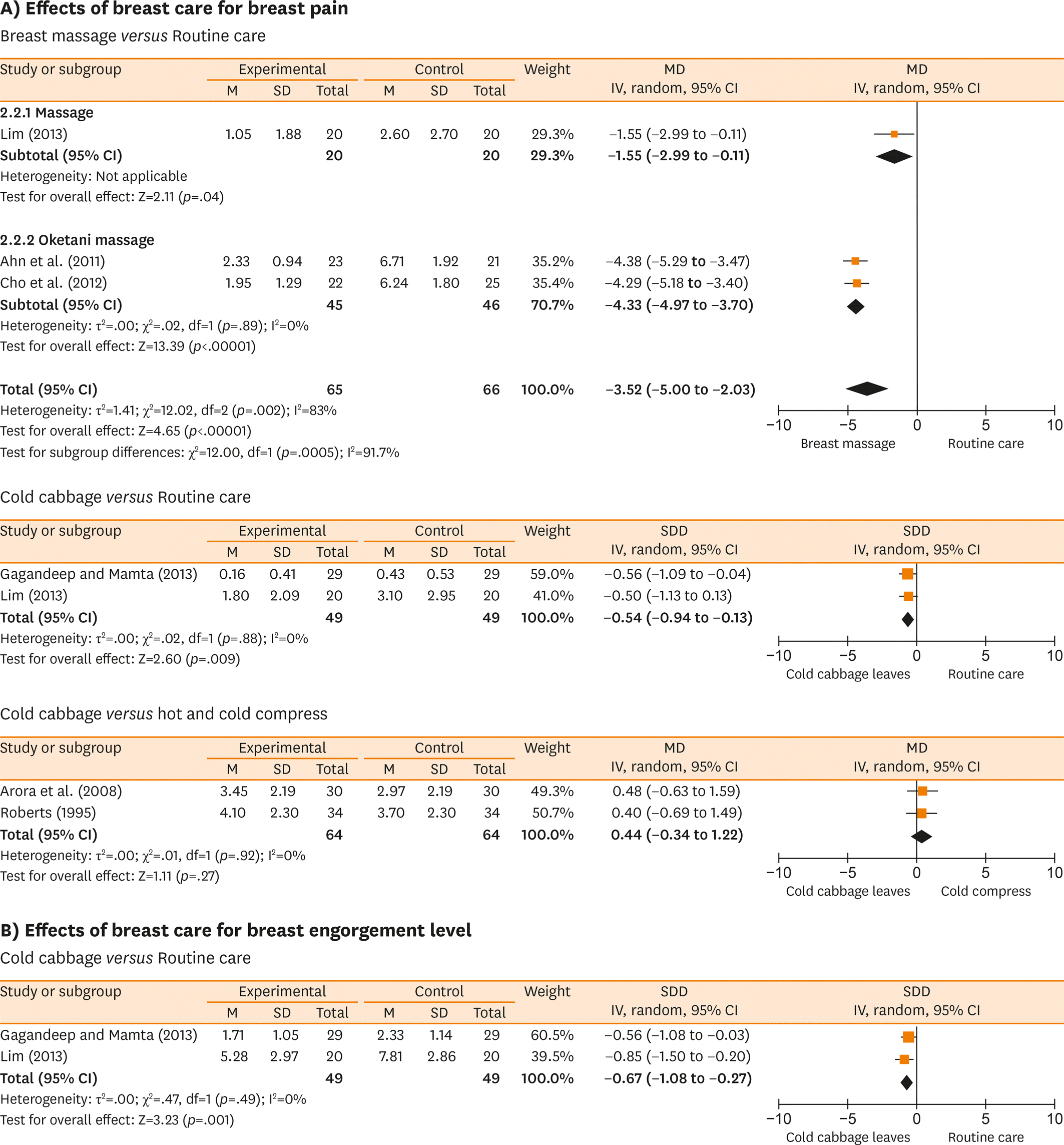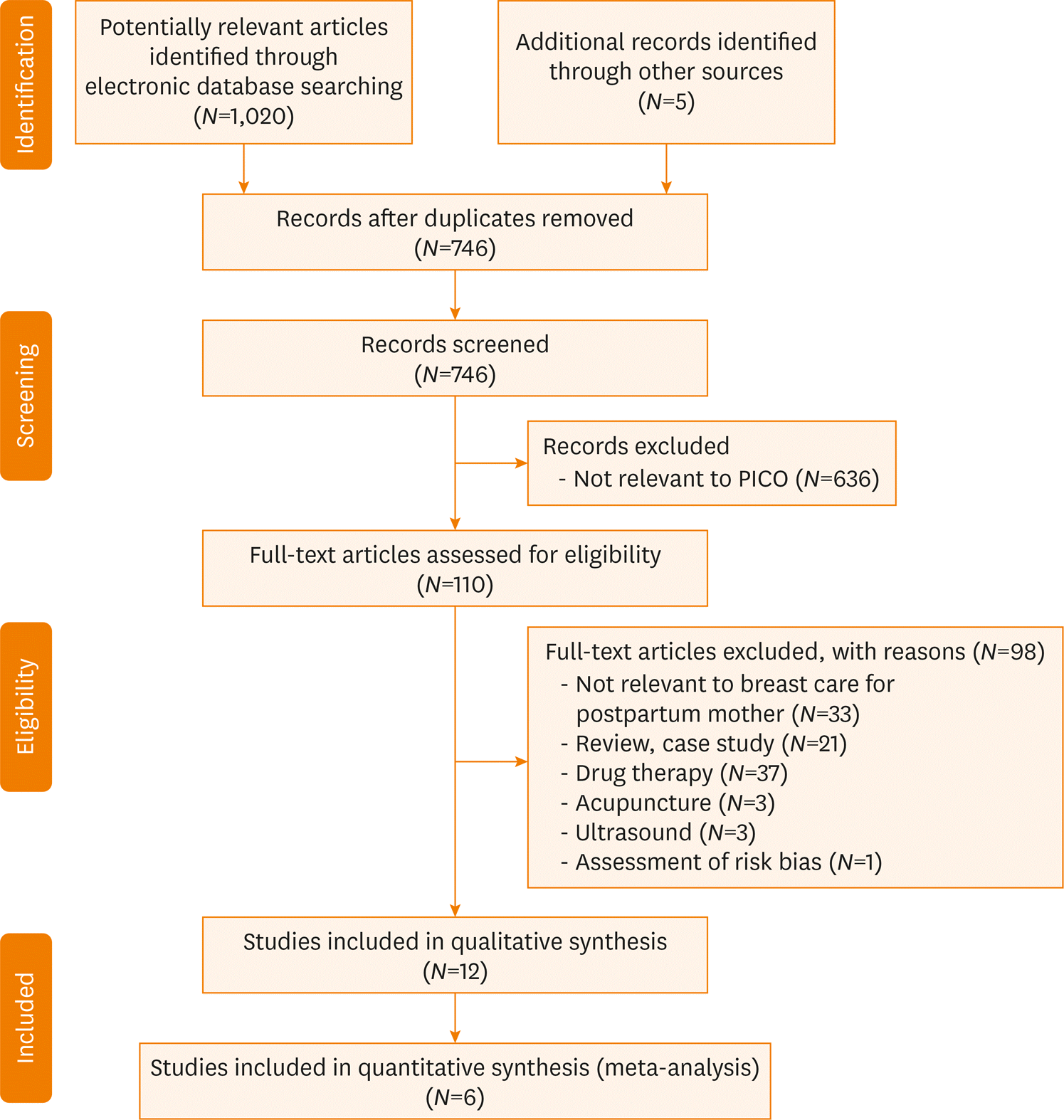Abstract
Purpose
The purpose of this study was to identify nursing interventions for the postpartum breast care of mothers and determine the effectiveness of interventions for breast pain and engorgement by systematic review.
Methods
Eight national and international databases were reviewed to retrieve and collect randomized controlled trial and controlled clinical trial literature published up to March 2015. Two reviewers independently selected the studies and performed data abstraction and validation. The risk of bias was assessed using Cochrane criteria. A meta-analysis of the studies was performed to analyze the data.
Results
The meta-analysis showed that breast massage, along with routine breast care, resulted in a 3.52-point reduction in pain on a 10-point visual analogue scale. Meta-analysis of therapy with cold cabbage leaves and routine breast care showed a pain reduction of 0.54 points. Meta-analysis of cold cabbage leaf application in the experimental group versus cold compress therapy in the comparison group showed a pain reduction of 0.44 points. Meta-analysis of cold cabbage leaf application and routine breast care showed an engorgement reduction of 0.67 points.
REFERENCES
1.Acheson LS., Danner SC. Postpartum care and breast-feeding. Primary care. 1993. 20(3):729–747. PUBMED.

2.Lawrence RA., Lawrence RM. Breastfeeding: a guide for the medical professional. 5th ed.St. Louis: Elsevier Health Sciences;1999. p. 233–258.
3.Li R., Fein SB., Chen J., Grummer-Strawn LM. Why mothers stop breastfeeding: mothers' self-reported reasons for stopping during the first year. Pediatrics. 2008. 122(Suppl 2):S69-S76.

4.Strong GD. Provider management and support for breastfeeding pain. Journal of Obstetric, Gynecologic, and Neonatal Nursing. 2011. 40(6):753–764.

5.Lee WT., Lui SS., Chan V., Wong E., Lau J. A population-based survey on infant feeding practice (0–2 years) in Hong Kong: breastfeeding rate and patterns among 3,161 infants below 6 months old. Asia Pacific Journal of Clinical Nutrition. 2006. 15(3):377–387. PUBMED.
6.Hussainy SY., Dermele N. Knowledge, attitudes and practices of health professionals and women towards medication use in breastfeeding: a review. International Breastfeeding Journal. 2011. 6:11.

7.Mangesi L., Dowswell T. Treatments for breast engorgement during lactation. Cochrane Database of Systematic Reviews. 2010. 9:CD006946.

8.Research Society of Women's Health Nursing Textbook. Women's health nursing. 8th ed.Paju: Soomoon-sa;2016. p. 516–517.
9.Snowden HM., Renfrew MJ., Woolridge MW. Treatments for breast engorgement during lactation. Cochrane Database of Systematic Reviews. 2001. 2:CD000046.

10.Anjum S. Hot fomentation versus cold compress for reducing intravenous infiltration. Nursing Journal of India. 2007. 98(11):253–254. PUBMED.
11.French SD., Cameron M., Walker BF., Reggars JW., Esterman AJ. A Cochrane review of superficial heat or cold for low back pain. Spine. 2006. 31(9):998–1006.

12.Pruthi S., Degnim AC., Bauer BA., DePompolo RW., Nayar V. Value of massage therapy for patients in a breast clinic. Clinical Journal of Oncology Nursing. 2009. 13(4):422–425.

13.Lauche R., Gräf N., Cramer H., Al-Abtah J., Dobos G., Saha FJ. Efficacy of cabbage leaf wraps in the treatment of symptomatic osteoarthritis of the knee: a randomized controlled trial. Clinical Journal of Pain. 2016. 32(11):961–971.
14.Arora S., Vatsa M., Dadhwal V. A comparison of cabbage leaves vs. hot and cold compresses in the treatment of breast engorgement. Indian Journal of Community Medicine. 2008. 33(3):160–162.
15.Nikodem VC., Danziger D., Gebka N., Gulmezoglu AM., Hofmeyr GJ. Do cabbage leaves prevent breast engorgement? A randomized, controlled study. Birth. 1993. 20(2):61–64.

16.Roberts KL. A comparison of chilled cabbage leaves and chilled gelpaks in reducing breast engorgement. Journal of Human Lactation. 1995. 11(1):17–20.

17.Roberts KL., Reiter M., Schuster D. A comparison of chilled and room temperature cabbage leaves in treating breast engorgement. Journal of Human Lactation. 1995. 11(3):191–194.

18.Roberts KL., Reiter M., Schuster D. Effects of cabbage leaf extract on breast engorgement. Journal of Human Lactation. 1998. 14(3):231–236.

19.Sauerland S., Seiler CM. Role of systematic reviews and meta-analysis in evidence-based medicine. World Journal of Surgery. 2005. 29(5):582–587.

20.Higgins JP., Green S. In: Cochrane handbook for systematic reviews of interventions. Hoboken: John Wiley & Sons;2011.
21.Kim WO. The study for the effect of breast massage and manual expression of the breast before engorgement after delivery. The Journal of Nurses Academic Society. 1975. 5(2):74–91. CROSSREF.

22.Lim AR. In: Comparative effectiveness of early breast care and cabbage compress on breast engorgement in primiparous women after cesarean birth [master's thesis]. Daejeon: Eulji University;2013. PUBMED.
23.Ahn S., Kim J., Cho J. Effects of breast massage on breast pain, breast-milk sodium, and newborn suckling in early postpartum mothers. Journal of Korean Academy of Nursing. 2011. 41(4):451–459.

24.Cho J., Ahn HY., Ahn S., Lee MS., Hur MH. Effects of Oketani breast massage on breast pain, the breast milk pH of mothers, and the sucking speed of neonates. Korean Journal of Women Health Nursing. 2012. 18(2):149–158. CROSSREF.

25.Cho J., Ahn S. Development and evaluation of breastfeeding promotion program for mothers with breast engorgement following cesarean birth. Journal of Korean Academy of Nursing. 2014. 44(2):170–178.

26.Chaithanya P. Effectiveness of cabbage leaves application on breast engorgement. Indian Journal of Applied Research. 2014. 4(12):472–474.
Figure 2.
Reviewing authors’ judgements about each risk of bias item presented as percentages across all included studies. (A) Risk of bias graph and (B) risk of bias summary.

Figure 3.
Forest plot of the effects of breast care for breast pain and breast engorgement level. Effects of breast care for (A) breast pain and (B) breast engorgement level. M=mean; SD=standard deviation; CI=confidence interval; df=degrees of freedom; MD=mean difference; SMD=standardized mean difference.

Table 1.
Summary of RCTs and CCTs Examining Breast Care and Breast Engorgement in Postpartum Mothers
Table 2.
Summary of General Characteristics




 PDF
PDF ePub
ePub Citation
Citation Print
Print



 XML Download
XML Download